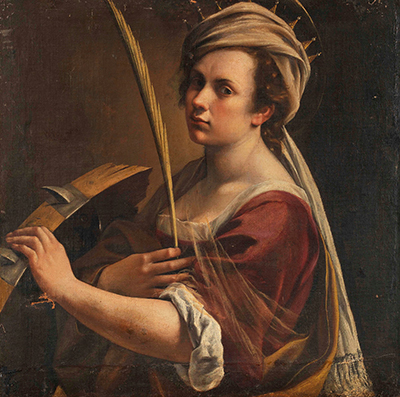In the modern era, Artemisia Gentileschi is seen by many as having been one of the most inspiring feminist icons since the Middle Ages, but was she really as strong-minded and tenacious as we are led to believe?
Quotes from her lifetime included below will help us to draw a clearer picture about her personality and also the environment in which she worked. In order to achieve what we did within a male-dominated industry was extraordinary and could never have been the case were she have had a relatively meek personality.
She was stubborn, bold and strong willed and needed all of these characteristics in order to leave the family home and make a name for herself independently. Barriers were consistently placed in front of her, particularly in the earlier stages of her career, but she was determined to avoid wasting the incredible natural talent that she had been blessed with.
The traumatic experiences that filled her life would also strengthen her character over time and make her more determined, if anything.
Famous Quotes by Artemisia Gentileschi
As long as I live I will have control over my being.
I have made a solemn vow never to send my drawings because people have cheated me. In particular, just today I found... that, having done a drawing of souls in Purgatory for the Bishop of St. Gata, he, in order to spend less, commissioned another painter to do the painting using my work. If I were a man, I can't imagine it would have turned out this way.
My illustrious lordship, i'll show you what a woman can do.
They [clients] come to a woman with this kind of talent, that is, to vary the subjects in my painting; never has anyone found in my pictures any repetition of invention, not even of one hand.
You will find the spirit of Caesar in this soul of a woman.
Quotes about Artemisia Gentileschi by Art Academics, Colleagues and Family Members
The only woman in Italy who has ever known what painting, color, and impasto is, and similar essentials.
Roberto Longhi
Artemisia is the most celebrated female painter of the 17th century. She worked in Rome, Florence, Venice, Naples and London, for the highest echelons of European society, including the Grand Duke of Tuscany and Philip IV of Spain.
The National Gallery, UK
Artemisia Gentileschi turned the horrors of her own life – repression, injustice, rape – into brutal biblical paintings that were also a war cry for oppressed women.
The Guardian
Artemisia Gentileschi was an early Italian Baroque painter, and the only female follower of Caravaggio, whom she worked with in Italy in the early 17th century. Her innovative compositions and focus on Biblical heroines set her apart from her male contemporaries and have lead to the celebration of Gentileschi as a painter with a uniquely female perspective.
Brooklyn Museum, USA
Although stylistically Artemisia Gentileschi's work owes a debt to that of Caravaggio and her father Orazio, her paintings place a greater emphasis on realism than her predecessors. Her compositions are also more energetic and during her career she carefully refined the use of texture and color, becoming known for her rich jewel hues and realistic flesh tones. Gentileschi subverted traditional depictions of the female protagonists of biblical and mythological stories presenting them as self-motivated heroines capable of making their own decisions rather than passive objects of the male gaze. In doing so she presented them in an entirely new way and this allowed them to possess a power that had been denied them by other artists.
TheArtStory.org
The revaluation of Artemisia's work has included a newfound appreciation of her technical skill, especially her command of chiaroscuro—a heightened juxtaposition of light and shadow. Chiaroscuro is most commonly associated with Caravaggio, who was an acquaintance of Artemisia's father, and whom she may have encountered as a young adolescent. (Caravaggio notoriously fled Rome in 1606, after killing another man in a duel.) One of Artemisia's greatest paintings, "Judith and Her Maidservant with the Head of Holofernes" (completed in the sixteen-twenties, and now owned by the Detroit Institute of Arts), offers a masterly execution of the technique, with its subjects illuminated, mid-action, by raking lamplight. In the background are virtuosic examples of still-life painting: a burnished brass candlestick, a draped velvet curtain.
Rebecca Mead, The New Yorker




